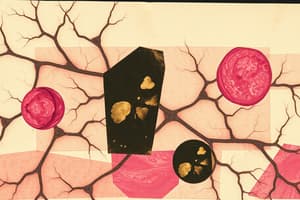Podcast
Questions and Answers
Which primary germ layer is responsible for the development of the majority of muscle tissue?
Which primary germ layer is responsible for the development of the majority of muscle tissue?
- Both ectoderm and endoderm
- Mesoderm (correct)
- Endoderm
- Ectoderm
Which of the following is NOT a function of connective tissue?
Which of the following is NOT a function of connective tissue?
- Compartmentalizing and transporting substances
- Binding tissues together
- Generating physical force for movement (correct)
- Providing immune response
What are the two main components of the extracellular matrix in connective tissue?
What are the two main components of the extracellular matrix in connective tissue?
- Protein fibers and ground substance (correct)
- Nerves and cartilage
- Cells and blood vessels
- Epithelial cells and collagen
Which of the following tissue types does NOT develop from the mesoderm?
Which of the following tissue types does NOT develop from the mesoderm?
Which tissue type is responsible for detecting changes in the body and responding with nerve impulses?
Which tissue type is responsible for detecting changes in the body and responding with nerve impulses?
What is a key characteristic of connective tissue regarding its blood supply, with exceptions?
What is a key characteristic of connective tissue regarding its blood supply, with exceptions?
Which of the primary germ layers gives rise to nervous tissue?
Which of the primary germ layers gives rise to nervous tissue?
Besides supporting and binding tissues, which of the following is another major function of connective tissues?
Besides supporting and binding tissues, which of the following is another major function of connective tissues?
Which tissue type covers body surfaces and lines hollow organs, body cavities, ducts, and forms glands?
Which tissue type covers body surfaces and lines hollow organs, body cavities, ducts, and forms glands?
Which of the following tissue types does NOT typically have a nerve supply?
Which of the following tissue types does NOT typically have a nerve supply?
Which of the following is NOT a primary function of the ground substance in connective tissue?
Which of the following is NOT a primary function of the ground substance in connective tissue?
What is a key difference between dense regular and dense irregular connective tissue?
What is a key difference between dense regular and dense irregular connective tissue?
In which type of connective tissue are chondrocytes found within lacunae?
In which type of connective tissue are chondrocytes found within lacunae?
Which of these connective tissues is characterized by a gelatin-like extracellular matrix (Wharton's Jelly)?
Which of these connective tissues is characterized by a gelatin-like extracellular matrix (Wharton's Jelly)?
What is the role of the pericondrium in cartilage?
What is the role of the pericondrium in cartilage?
Which type of loose connective tissue serves as the initial site of pathogen encounter if epithelia are breached?
Which type of loose connective tissue serves as the initial site of pathogen encounter if epithelia are breached?
Which of the following best describes the arrangement of fibers in reticular connective tissue?
Which of the following best describes the arrangement of fibers in reticular connective tissue?
What is a major functional difference between white and brown adipose tissue?
What is a major functional difference between white and brown adipose tissue?
Which type of cells secrete antibodies?
Which type of cells secrete antibodies?
In which of the following locations would you expect to find dense regular connective tissue?
In which of the following locations would you expect to find dense regular connective tissue?
Which characteristic is NOT commonly associated with hyaline cartilage?
Which characteristic is NOT commonly associated with hyaline cartilage?
What is a key distinguishing feature of fibrocartilage compared to other types of cartilage?
What is a key distinguishing feature of fibrocartilage compared to other types of cartilage?
Which of these best describes the location of chondrocytes within elastic cartilage?
Which of these best describes the location of chondrocytes within elastic cartilage?
What is a significant implication of cartilage being avascular?
What is a significant implication of cartilage being avascular?
Which process describes the growth of cartilage from within the tissue itself?
Which process describes the growth of cartilage from within the tissue itself?
What is the primary structural difference between spongy bone and compact bone at the microscopic level?
What is the primary structural difference between spongy bone and compact bone at the microscopic level?
Which component is NOT part of bone tissue as defined in the context?
Which component is NOT part of bone tissue as defined in the context?
What is the primary function of the perichondrium?
What is the primary function of the perichondrium?
The ground substance of cartilage is MOST directly responsible for which property?
The ground substance of cartilage is MOST directly responsible for which property?
What is the primary difference in the composition of the extracellular matrix between hyaline cartilage and elastic cartilage?
What is the primary difference in the composition of the extracellular matrix between hyaline cartilage and elastic cartilage?
Flashcards
Epithelial Tissue
Epithelial Tissue
Covers body surfaces and lines hollow organs, body cavities, ducts, and forms glands.
Connective Tissue
Connective Tissue
Protects, supports, and binds organs. Stores energy as fat, and provides immunity.
Muscular Tissue
Muscular Tissue
Generates the physical force needed to make body move and generate heat.
Nervous Tissue
Nervous Tissue
Signup and view all the flashcards
Germ Layers
Germ Layers
Signup and view all the flashcards
Connective Tissue
Connective Tissue
Signup and view all the flashcards
Functions of Connective Tissue
Functions of Connective Tissue
Signup and view all the flashcards
Extracellular Matrix
Extracellular Matrix
Signup and view all the flashcards
Vascularity of Connective Tissue
Vascularity of Connective Tissue
Signup and view all the flashcards
Innervation of Connective Tissue
Innervation of Connective Tissue
Signup and view all the flashcards
Fibroblasts
Fibroblasts
Signup and view all the flashcards
Adipocytes (Fat Cells)
Adipocytes (Fat Cells)
Signup and view all the flashcards
Mast Cells
Mast Cells
Signup and view all the flashcards
White Blood Cells
White Blood Cells
Signup and view all the flashcards
Macrophages
Macrophages
Signup and view all the flashcards
Plasma Cells
Plasma Cells
Signup and view all the flashcards
Ground Substance
Ground Substance
Signup and view all the flashcards
Collagen Fibers
Collagen Fibers
Signup and view all the flashcards
Elastic Fibers
Elastic Fibers
Signup and view all the flashcards
Elastic Cartilage
Elastic Cartilage
Signup and view all the flashcards
Hyaline Cartilage
Hyaline Cartilage
Signup and view all the flashcards
Perichondrium
Perichondrium
Signup and view all the flashcards
Fibrocartilage
Fibrocartilage
Signup and view all the flashcards
Interstitial Growth
Interstitial Growth
Signup and view all the flashcards
Appositional Growth
Appositional Growth
Signup and view all the flashcards
Osteon (Haversian system)
Osteon (Haversian system)
Signup and view all the flashcards
Spongy Bone
Spongy Bone
Signup and view all the flashcards
Bone Tissue
Bone Tissue
Signup and view all the flashcards
Blood Plasma
Blood Plasma
Signup and view all the flashcards
Study Notes
Connective Tissues - Introduction
- Connective tissues are the most abundant and widely distributed tissues in the body.
- They have many functions, including binding tissues together, providing support and strength, protecting and insulating internal organs, compartmentalizing and transporting, and storing energy reserves and participating in immune responses.
Four Types of Tissues
- Epithelial: Covers body surfaces and lines hollow organs, body cavities, ducts, and forms glands.
- Connective: Protects, supports, and binds organs; stores energy as fat, and provides immunity.
- Muscular: Generates the physical force needed for movement and creates body heat.
- Nervous: Detects changes in the body and responds by generating nerve impulses.
Development of Tissues
- Tissues develop from three primary germ layers: ectoderm, endoderm, and mesoderm.
- Epithelial tissues develop from all three germ layers.
- Most connective tissues and muscle tissues originate from mesoderm.
- Nervous tissue originates from ectoderm.
Connective Tissue
- Connective tissue is found between cells.
- It is composed of protein fibers and ground substance.
- Connective tissue is highly vascular and supplied with nerves, with exceptions such as cartilage and tendons, which have little to no blood supply and nerves.
Connective Tissue Cells
- Fibroblasts: Secretes fibers and components of ground substance.
- Adipocytes (fat cells): Store triglycerides (fat).
- Mast cells: Produce histamine.
- White blood cells: Participate in the immune response (Neutrophils and Eosinophils).
- Macrophages: Engulf bacteria and cellular debris via phagocytosis.
- Plasma cells: Secret antibodies.
Connective Tissue Extracellular Matrix
- Ground substance: Located between cells and fibers, it can be fluid, semi-fluid, gelatinous, or calcified; it supports and binds cells, stores water, and facilitates exchange between blood and cells; it's a complex combination of proteins and polysaccharides.
- Fibers: Include collagen, elastic, and reticular fibers.
Classification of Connective Tissues
- Embryonic connective tissue: Mesenchyme and mucous connective tissue (Wharton's Jelly, found in the umbilical cord of the fetus)
- Mature connective tissue (proper): Loose connective tissue (areolar, adipose, and reticular), Dense connective tissue (dense regular, dense irregular, and elastic)
- Cartilage: Hyaline, fibrocartilage, and elastic cartilage
- Bone tissue
- Fluid connective tissue: Blood and lymph
Loose Connective Tissue
- Areolar: Most widely distributed.
- Adipose: Contains adipocytes for insulation and energy storage, and produces hormones and cytokines.
- Reticular: Forms stroma of liver, spleen, and lymph nodes; made of delicate reticular fibers and cells.
Dense Connective Tissue
- Dense regular: Bundles of collagen fibers in parallel for strength; found in tendons and most ligaments.
- Dense irregular: Irregularly arranged collagen fibers for strength in many directions; found in the dermis of skin and heart.
- Elastic: Contains branching elastic fibers for strength and recoil ability; found in lung tissue and arteries.
Cartilage
- Composed of chondrocytes located in lacunae.
- Types include hyaline (most abundant, in the skeleton), fibrocartilage (strongest), and elastic (flexible).
- Supported by perichondrium (a dense irregular connective tissue covering).
- Avascular, so cartilage repair is slow.
- Growth occurs through interstitial and appositional growth.
Bone Tissue
- Bones are organs made of bone tissue, periosteum, and endosteum.
- Compact bone contains osteons (Haversian systems).
- Spongy bone lacks osteons but has trabeculae.
Fluid Connective Tissue
- Includes blood (plasma as the fluid extracellular matrix) and lymph.
Studying That Suits You
Use AI to generate personalized quizzes and flashcards to suit your learning preferences.



